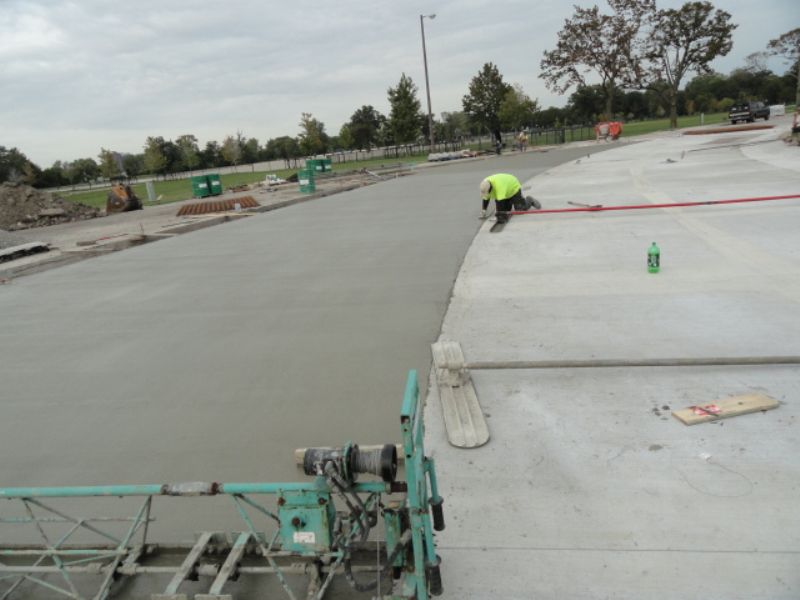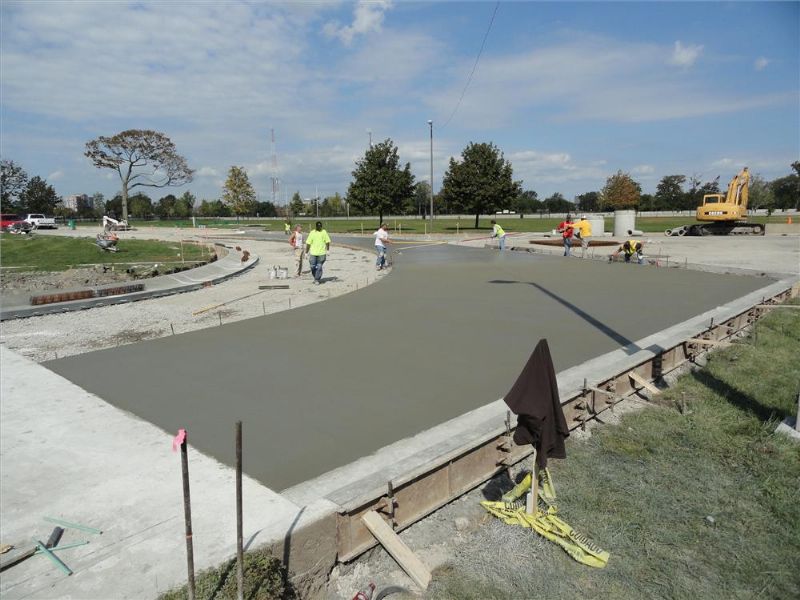Organization Paves Way for IndyCar Racing’s Return
 |
 |
After a three-year absence, IndyCar racing returned to Belle Isle last June, but a triumphant return was marred when the Detroit Grand Prix was red-flagged for two hours to repair two sections of the circuit after the track began to fall apart. Fans watched at the track and on live TV while crews scrambled to fill holes and replace long strips of synthetic rubber that had come loose. Once the temporary fix was completed, only 60 of the scheduled 90 laps were completed, due to time constraints.
After the race, the Chevrolet Detroit Belle Isle Grand Prix, a 501(c)3 organization and subsidiary of the Downtown Detroit Partnership, conducted an engineering evaluation of the circuit to determine the extent of the repairs needed. “The concrete broke at the joints," said Gary Baise, operations director. “It had been neglected."
A deluge of rain and water pressure from the Detroit River caused the concrete to fail, Baise said. Core samples revealed that no sealer had been used, so when water got in the joints and went through Michigan’s freeze-thaw cycles, the concrete cracked at different elevations. Because the cracks were longitudinal, cars were racing on them for extended periods, heating up the sealer and making it pliable. When the sealer became flexible, it pulled on the concrete, tearing it out all the way down to the next layer where it was cracked.
Repairing Racing Damage
Repaving the roadways on Belle Isle was not on the city’s agenda, but repairs were necessitated because of the damage done by the race cars.
Belle Isle is a 982-acre island park in the Detroit River between the United States mainland and Canada, connected to the rest of Detroit by the MacArthur Bridge.
Although the island generates a lot of traffic during the summer – as many as 6 million vehicles – a city park was not a priority for an economically troubled city. But because legendary team owner Roger Penske was responsible for bringing the series back to the Motor City, repairs were going to be done right. The $1.2-1.3 million budget even includes contingency money.
“We had a base number going in, but we expected surprises so we had ‘surprise money’ built in," Baise said. “Roger wanted it to look good, so we extended the concrete in some areas just for aesthetics."
They took a “race track approach" to paving, Baise said. “We have to. The specs are higher, more refined, and the tolerances are closer." To achieve the desired tolerances, they brought in Wolverine Engineers and Surveyors, out of Mason, OH. It may seem like a long way to go for an engineer, said Baise, but having used them at Michigan International Speedway in the 1980s through the 1990s, he knew they had expertise with race tracks.
Their input may be even more critical because, in addition to paving work, the circuit for the 2013 Chevrolet Detroit Belle Isle Grand Prix is being modified to enhance competition. The course will be extended one-quarter mi. to 2.346 mi., the track length utilized from 1997-2001, by adding a half-mile straightaway through the tree-lined center of the island.
“We’re taking one turn out and making a longer straight for more passing opportunities, due to complaints about the lack of passing," Baise said.
Drivers on hand for a press conference during construction were pleased with the changes. “It will be a more suitable racetrack for us, with more passing opportunities," said Sebastien Bourdais, an IndyCar regular.
“It’s going to be a lot faster and a lot smoother," said Oriol Servia, another IndyCar veteran.
“The Chevrolet Detroit Belle Isle Grand Prix team is enhancing Belle Isle to make it a more challenging, world-class road course for all the great series competing on the island," said General Motors North America President Mark Reuss.
“It will definitely give us another place to pass," said series veteran Tony Kanaan. “That’s a good thing on this track, and it should make things more exciting for the fans."
Despite the emphasis on preparing the surface for racing, this roadway serves the public 51 weeks a year. “We always have to remember that we aren’t only building a racing surface; we’re building something that has to survive as a public road during a Michigan winter," Baise said.
“That’s the reason this was such an expensive project," said Bud Denker, chairman of the Board of Detroit Belle Isle. “We’ve done engineering studies far beyond anything that has been done for this track or this island before."
Under the Surface
Local contractors M&B Contracting, from Metamora, Ill., and Pollard Concrete Services, both of whom have done work on the island before, partnered on this project.
The first step was to have a small demolition crew of three operators and 3-4 trucks remove deteriorated concrete areas of the racing surface. Broken concrete was chipped out in preparation for hot rubber sealer to fill the void.
The core samples tell them if the cracks are isolated or deep. Where there’s only a superficial top layer problem, crews “bust out" the damaged sections and apply a skim coat. If they’re deep, they then have to decide how to patch: remove large blocks of concrete or apply crack sealer. “We’re doing the bad sections," Baise said, “by taking up all the [temporary] sealant and replacing it with concrete sealant."
In addition to the core samples from around the track, they videotaped sewer lines to look for damage and drainage obstructions. “The pipe was crushed in some areas," said Baise. “Tree roots that grew in had to be machine-cut out."
Chunks of concrete were found underground, 150 ft. from manholes, but due to a limited budget, they are unable to be addressed for the time being. However, if there is a problem in the future, Baise said they know what needs to be done and “what’s under there."
Belle Isle is a “flat piece of ground that’s hard to drain," as Baise describes it. The water table is high on the island, complicating drainage. Infrastructure that is 40 to 50 years old hasn’t been able to withstand the weather or the wear and tear. Old catch basins were not precast; they were poured in place or created using cement block.
Because of those factors, wherever crews worked on the road, they also rebuilt underneath: catch basins, new concrete pipes and new edge drains to get rid of the water. Turn 11 is one of the areas that has all new catch basin and piping.
Paving the Way for a Better Race
Not all of the underground work involved plumbing. Baise explains that the previous promoter had to cover the track surface between Turns 3 and 4 between races with dirt and grass. That now has to be removed. “We’re still cleaning, but the concrete buried beneath it is in good shape," he said. However, the shoulders will have to be re-graded for drainage.
After the storm sewer work, curb work was next on the chain of events. Crews worked on elevations and baseline. Next, they did the flat work: forming for roadway itself. It was complicated in some areas because they had to warp the road pitch at the crown to meet the turns, but still ensure that drainage goes to the catch basins, not into an off-camber collection area.
The job required 84,000 to 86,000 sq. ft. (25603.2 to 26212.8 m) of concrete 9 in. thick with steel reinforcement for the road and curb. Baise estimates that 40 to 50 guys were on site for big pours. “We poured center-to-curb on both sides and tied in the middle with steel pins."
In addition to the 6-inch box curbs bordering the track, red and white “racing curbs" were poured with no breaks. These curbs, roughly 24-30 in. wide, extend two feet into the roadway to create chicanes the drivers have to maneuver.
The roadway still has seams. “They’re necessary expansion joints for movement because of the freeze-thaw cycles," Baise said. Approximately 3,000 sq. ft. (914.4 m) of asphalt is being installed in limited areas, such as the new straightway, which has raised manholes. Fifty feet of the old Turn 3 and 75-100 ft (22.9-30.5 m) of the new Turn 3 are also getting asphalt in areas where the old asphalt came unraveled, according to Baise.
Although the asphalt mix used was “a little different" than the typical mix, “regular" concrete was used on the project. “We had to stay with products in city code," Baise said. The Grand Prix may have funded the project, but the city had approval, so crews had to build to city specifications.
Racing the Clock
Work on the Belle Isle track began on Sept. 11 and is expected to be completed soon if rain doesn’t interfere with the schedule. Sidewalks, landscaping and seeding still need to be done. The six-week schedule is especially impressive, considering there were about six days when crews couldn’t work because they were waiting on test results to determine if the concrete was strong enough to drive on, said Baise.
The compressed schedule – an attempt to beat the weather – put pressure on the team, as did the need to maintain access during the project. “We only closed certain sections," Baise said. “One section was closed two weeks, another five weeks – but people could go around the island because we left the Strand open. It didn’t affect use of the park."
The real test will come next June 1-2, when the IZOD IndyCar series returns for the “Dual in Detroit" – two 70-lap races, one of which will introduce standing starts. “We’re so excited to host the first IndyCar doubleheader of the season," Denker said, adding that his goal is to make the race a permanent fixture on the schedule. “Our vision is to have this race here for a long time."
While the tight schedule may have added extra pressure, knowing that the 2013 IndyCar event is the series’ first double-header doesn’t. “We want it to be right because it needs to be," said Baise. ConstructionEquipmentGuide.com
